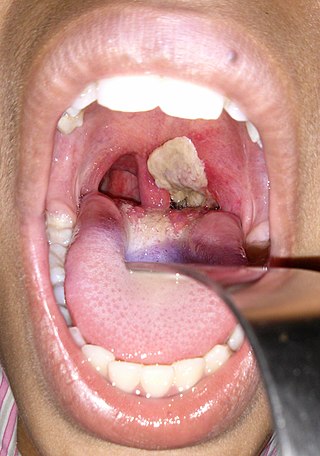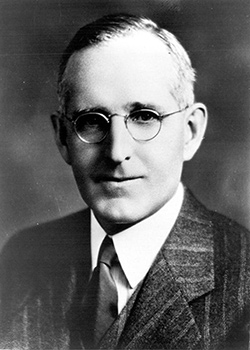
Diphtheria is an infection caused by the bacterium Corynebacterium diphtheriae. Most infections are asymptomatic or have a mild clinical course, but in some outbreaks, the lethality rate approaches 10%. Signs and symptoms may vary from mild to severe, and usually start two to five days after exposure. Symptoms often develop gradually, beginning with a sore throat and fever. In severe cases, a grey or white patch develops in the throat, which can block the airway, and create a barking cough similar to what is observed in croup. The neck may also swell in part due to the enlargement of the facial lymph nodes. Diphtheria can also involve the skin, eyes, or genitals, and can cause complications, including myocarditis, inflammation of nerves, kidney problems, and bleeding problems due to low levels of platelets.

An antitoxin is an antibody with the ability to neutralize a specific toxin. Antitoxins are produced by certain animals, plants, and bacteria in response to toxin exposure. Although they are most effective in neutralizing toxins, they can also kill bacteria and other microorganisms. Antitoxins are made within organisms, and can be injected into other organisms, including humans, to treat an infectious disease. This procedure involves injecting an animal with a safe amount of a particular toxin. The animal's body then makes the antitoxin needed to neutralize the toxin. Later, blood is withdrawn from the animal. When the antitoxin is obtained from the blood, it is purified and injected into a human or other animal, inducing temporary passive immunity. To prevent serum sickness, it is often best to use an antitoxin obtained from the same species.

Max Theiler was a South African-American virologist and physician. He was awarded the Nobel Prize in Physiology or Medicine in 1951 for developing a vaccine against yellow fever in 1937, becoming the first African-born Nobel laureate.
Dr. Anna Wessels Williams (1863–1954) was an American pathologist at the first municipal diagnostic laboratory in the United States. She used her medical training from the Women's Medical College of the New York Infirmary for research rather than medical practice, and over the course of her career worked on developing vaccines, treatments and diagnostic tests for many diseases, including diphtheria, rabies, scarlet fever, smallpox, influenza, and meningitis. Notably, a strain of diphtheria-causing bacteria that Williams isolated and cultivated was instrumental in producing an antitoxin to bring the disease under control. In 1932, she became the first woman to be elected chair of the laboratory section of the American Public Health Association.

On October 2, 1901, a former milk wagon horse named Jim showed signs that he had contracted tetanus and was euthanized. He was used to produce serum containing diphtheria antitoxin. Jim produced over 30 US quarts of diphtheria antitoxin in his career. After the death of a girl in St. Louis, Missouri, was traced back to Jim's contaminated serum, it was discovered that serum dated September 30 contained tetanus in its incubation phase. This contamination could have easily been discovered if the serum had been tested prior to its use. Furthermore, samples from September 30 had also been used to fill bottles labeled "August 24", while actual samples from the 24th were shown to be free of contamination.

Diphtheria antitoxin (DAT) is a medication made up of antibodies used in the treatment of diphtheria. It is no longer recommended for prevention of diphtheria. It is given by injection into a vein or muscle.

The Lister Institute of Preventive Medicine, informally known as the Lister Institute, was established as a research institute in 1891, with bacteriologist Marc Armand Ruffer as its first director, using a grant of £250,000 from Edward Cecil Guinness of the Guinness family. It had premises in Chelsea in London, Sudbury in Suffolk, and Elstree in Hertfordshire, England. It was the first medical research charity in the United Kingdom. It was renamed the Jenner Institute in 1898 and then, in 1903, as the Lister Institute in honour of the great surgeon and medical pioneer, Dr Joseph Lister. In 1905, the institute became a school of the University of London.

Diphtheria vaccine is a toxoid vaccine against diphtheria, an illness caused by Corynebacterium diphtheriae. Its use has resulted in a more than 90% decrease in number of cases globally between 1980 and 2000. The first dose is recommended at six weeks of age with two additional doses four weeks apart, after which it is about 95% effective during childhood. Three further doses are recommended during childhood. It is unclear if further doses later in life are needed.

John Gerald "Gerry" FitzGerald was a Canadian physician and public health specialist who was instrumental in the control of diphtheria, first by producing and freely distributing antitoxin, and then in 1924 by using mass production to enable widespread use of the vaccine devised by Gaston Ramon.

Alexander Thomas Glenny, was a British immunologist known particularly for his work on the prevention of diphtheria.
Henry Frieze Vaughan was an American epidemiologist with a strong discipline in environmental health, an academic professor, and an administrator. Among the positions he held, he was the Health Commissioner for the City of Detroit (1919–1941), editor for “American Journal of Public Health” (1922–1924), President of American Public Health in 1925, trustee of the W. K. Kellogg Foundation (1933–1978), President of Council at the Michigan Department of Council (1939–1960), founder and Dean of the University of Michigan School of Public Health (1941–1960), and the co-founder and first president of the National Sanitation Foundation (1944–1966). Vaughan was born in Michigan and stayed in Michigan for most of his life contributing to the development and innovation of medical and health services in Michigan.

Frieda Fraser was a Canadian physician, scientist and academic who worked in infectious disease, including research on scarlet fever and tuberculosis. After finishing her medical studies at the University of Toronto in 1925, she completed a two-year internship in the United States, studying and working in Manhattan and Philadelphia. Afterward, she conducted research in the Connaught Laboratories concentrating on infectious disease, making important contributions in the pre-penicillin age to isolation of the strains of streptococci likely to lead to disease. From 1928, she lectured in the Department of Hygiene at the University of Toronto on preventive medicine, working her way up from a teaching assistant to a full professor by 1955. In college, around 1917 Fraser met her life partner, Edith Williams, and though their families tried to keep them apart, their relationship spanned until Edith's death in 1979. The correspondence between the two has been preserved and is an important legacy for the lesbian history of Canada.
Leone Norwood Farrell (1904–1986) was a Canadian biochemist and microbiologist who identified microbial strains of industrial importance and developed innovative techniques for the manufacture of vaccines and antibiotics. Her inventions enabled the mass production of the polio vaccine.

The Connaught Medical Research Laboratories was a non-commercial public health entity established by Dr. John G. FitzGerald in 1914 in Toronto to produce the diphtheria antitoxin. Contemporaneously, the institution was likened to the Pasteur Institutes in France and Belgium and the Lister Institute in London. It expanded significantly after the discovery of insulin at the University of Toronto in 1921, manufacturing and distributing insulin at cost in Canada and overseas. Its non-commercial mandate mediated commercial interests and kept the medication accessible. In the 1930s, methodological advances at Connaught updated the international standard for insulin production.
Edith M. Taylor (1899-1993) was a Canadian biochemist known primarily for her work in producing novel techniques in vaccine production, especially her work on the production of diphtheria toxoid, while employed as a researcher by Connaught Laboratories in Toronto, Canada.

Ernest Steven MonteiroBBM PJG FRFPS was a Singaporean physician, specialised in preventive medicine. He also served as the Singapore Ambassador to Brazil, Cambodia and the United States.

Wellbee was an American cartoon character and public health mascot that first appeared in 1962. He was an anthropomorphic bumblebee created by Hollywood artist Harold M. Walker at the request of Centers for Disease Control and Prevention's (CDC) public information officer George M. Stenhouse. The character became CDC's national symbol of public health at the time, and was widely used to promote immunization and other public health campaigns in the United States following the Vaccination Assistance Act of 1962.
Peter Joseph Moloney was a Canadian chemist. He is known for his work on developing vaccines against diphtheria and tetanus, purifying insulin preparations for clinical use, demonstrating antibodies against insulin in humans and animals, and developing sulfated insulin preparations for the treatment of diabetics with insulin resistance. He also invented a quick-acting pH electrode and helped to develop an antiserum that was used in WW II for protection against gas gangrene.
Elizabeth Miller is a British epidemiologist and professor at the London School of Hygiene and Tropical Medicine. She worked at the Public Health Laboratory Service and Public Health England, researching the safety and effectiveness of new and existing vaccination programmes. Prominent work included investigating the link between MMR vaccine and autism, finding no evidence to support a causal association between these.















